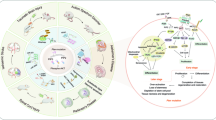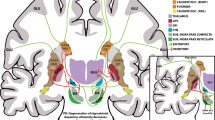Abstract
The central nervous system has limited capacity of regenerating lost tissue in slowly progressive, degenerative neurological conditions such as Parkinson's disease (PD), Alzheimer's disease or Huntington's disease (HD), or in acute injuries resulting in rapid cell loss for example, in cerebrovascular damage (for example, stroke) or spinal cord injury. Although the adult brain contains small numbers of stem cells in restricted areas, they do not contribute significantly to functional recovery. Transplantation of stem cells or stem cell-derived progenitors has long been seen as a therapeutic solution to repair the damaged brain. With the advent of the induced pluripotent stem cells technique a new and potentially better source for transplantable cells may be available in future. This review aims to highlight current strategies to replace lost cellular populations in neurodegenerative diseases with the focus on HD and PD and traumatic brain injuries such as stroke, discussing many of the technical and biological issues associated with central nervous system cell transplantation.
This is a preview of subscription content, access via your institution
Access options
Subscribe to this journal
Receive 12 print issues and online access
$259.00 per year
only $21.58 per issue
Buy this article
- Purchase on Springer Link
- Instant access to full article PDF
Prices may be subject to local taxes which are calculated during checkout


Similar content being viewed by others
References
Zietlow R, Lane EL, Dunnett SB, Rosser AE . Human stem cells for CNS repair. Cell Tissue Res 2008; 331: 301–322.
Kim SU, de Vellis J . Stem Cell-Based Cell Therapy in Neurological Diseases: A Review. J Neurosci Res 2009; 87: 2183–2200.
Lovell-Badge R . The regulation of human embryo and stem-cell research in the United Kingdom. Nat Rev Mol Cell Biol 2008; 9: 998–1003.
Mathews DJ, Sugarman J, Bok H, Blass DM, Coyle JT, Duggan P et al. Cell-based interventions for neurologic conditions: ethical challenges for early human trials. Neurology 2008; 71: 288–293.
Anderson L, Burnstein RM, He X, Luce R, Furlong R, Foltynie T et al. Gene expression changes in long term expanded human neural progenitor cells passaged by chopping lead to loss of neurogenic potential in vivo. Exp Neurol 2007; 204: 512–524.
Takahashi K, Yamanaka S . Induction of pluripotent stem cells from mouse embryonic and adult fibroblast cultures by defined factors. Cell 2006; 126: 663–676.
Takahashi K, Tanabe K, Ohnuki M, Narita M, Ichisaka T, Tomoda K et al. Induction of pluripotent stem cells from adult human fibroblasts by defined factors. Cell 2007; 131: 861–872.
Yu J, Vodyanik MA, Smuga-Otto K, Antosiewicz-Bourget J, Frane JL, Tian S et al. Induced pluripotent stem cell lines derived from human somatic cells. Science 2007; 318: 1917–1920.
Dunnett SB, Rosser AE . Stem cell transplantation for Huntington's disease. Exp Neurol 2007; 203: 279–292.
Krystkowiak P, Gaura V, Labalette M, Rialland A, Remy P, Peschanski M et al. Alloimmunisation to Donor Antigens and Immune Rejection Following Foetal Neural Grafts to the Brain in Patients with Huntington's disease. PLoS One 2007; 1: e166.
Keene CD, Sonnen JA, Swanson PD, Kopyov O, Leverenz JB, Bird TD et al. Neural transplantation in Huntington disease: long-term grafts in two patients. Neurology 2007; 68: 2093–2098.
Keene CD, Chang RC, Leverenz JB, Kopyov O, Perlman S, Hevner RF et al. A patient with Huntington's disease and long-surviving fetal neural transplants that developed mass lesions. Acta Neuropathol 2009; 117: 329–338.
Reuter I, Tai YF, Pavese N, Chausdhuri KR, Mason S, Polkey CE et al. Long-term clinical and positron emission tomography outcome of fetal striatal transplantation in Huntington's disease. J Neurol Neurosurg Psychiatry 2008; 79: 948–951.
Capetian P, Knoth R, Maciaczyk J, Pantazis G, Ditter M, Bokla L et al. Histological findings on fetal striatal grafts in a Huntington's disease patient early after transplantation. Neuroscience 2009; 160: 661–675.
Cicchetti F, Saporta S, Hauser RA, Parent M, Saint-Pierre M, Sanberg PR et al. Neural transplants in patients with Huntington's disease undergo disease-like neuronal degeneration. Proc Natl Acad Sci USA 2009; 106: 12483–12488.
Minger SL, Ekonomou A, Carta EM, Chinoy A, Perry RH, Ballard CG . Endogenous neurogenesis in the human brain following cerebral infarction. Regen Med 2007; 2: 69–74.
Ekonomou A, Ballard CG, Pathmanaban ON, Perry RH, Perry EK, Kalaria RN et al. Increased neural progenitors in vascular dementia. Neurobiol Aging 2010. E-pub ahead of print.
Lee HJ, Park IH, Kim HJ, Kim SU . Human neural stem cells overexpressing glial cell line-derived neurotrophic factor in experimental cerebral hemorrhage. Gene Ther 2009; 16: 1066–1076.
Lee HJ, Kim K, Park IH, Kim SU . Human Neural Stem Cells Over-Expressing VEGF Provide Neuroprotection, Angiogenesis and Functional Recovery in Mouse Stroke Model. PLoS One 2007; 2: e156.
Savitz SI, Dinsmore J, Wu J, Henderson GV, Stieg P, Caplan LR . Neurotransplantation of fetal porcine cells in patients with basal ganglia infarcts: a preliminary safety and feasibility study. Cerebrovasc Dis 2005; 20: 101–107.
Bang OY, Lee JS, Lee PH, Lee G . Autologous mesenchymal stem cell transplantation in stroke patients. Ann Neurol 2005; 57: 874–882.
Andres RH, Choi R, Steinberg GK, Guzman R . Potential of adult neural stem cells in stroke therapy. Regen Med 2008; 3: 893–905.
Bliss TM, Andres RH, Steinberg GK . Optimizing the success of cell transplantation therapy for stroke. Neurobiol Dis 2010; 37: 275–283.
Locatelli F, Bersano A, Ballabio E, Lanfranconi S, Papadimitriou D, Strazzer S et al. Stem cell therapy in stroke. Cell Mol Life Sci 2009; 66: 757–772.
Nakano-Doi A, Nakagomi T, Fujikawa M, Nakagomi N, Kubo S, Lu S et al. Bone Marrow Mononuclear Cells Promote Proliferation of Endogenous Neural Stem Cells Through Vascular Niches After Cerebral Infarction. Stem Cells 2010; 28: 1292–1302.
Nakagomi N, Nakagomi T, Kubo S, Nakano-Doi A, Saino O, Takata M et al. Endothelial cells support survival, proliferation, and neuronal differentiation of transplanted adult ischemia-induced neural stem/progenitor cells after cerebral infarction. Stem Cells 2009; 27: 2185–2195.
Fan Y, Shen F, Frenzel T, Zhu W, Ye J, Liu J et al. Endothelial progenitor cell transplantation improves long-term stroke outcome in mice. Ann Neurol 2010; 4: 488–497.
Yamashita T, Deguchi K, Nagotani S, Kamiya T, Abe K . Gene and stem cell therapy in ischemic stroke. Cell Transplant 2009; 18: 999–1002.
Chen B, Gao XQ, Yang CX, Tan SK, Sun ZL, Yan NH et al. Neuroprotective effect of grafting GDNF gene-modified neural stem cells on cerebral ischemia in rats. Brain Res 2009; 1284: 1–11.
Lindvall O, Kokaia Z . Prospects of stem cell therapy for replacing dopamine neurons in Parkinson's disease. Trends Pharmacol Sci 2009; 30: 260–267.
Isacson O, Kordower JH . Future of cell and gene therapies for Parkinson's disease. Ann Neurol 2008; 64 (Suppl 2): S122–S138.
Li QJ, Tang YM, Liu J, Zhou DY, Li XP, Xiao SH et al. Treatment of Parkinson disease with C17.2 neural stem cells overexpressing NURR1 with a recombined republic-deficit adenovirus containing the NURR1 gene. Synapse 2007; 61: 971–977.
Wijeyekoon R, Barker RA . Cell replacement therapy for Parkinson's disease. Biochim Biophys Acta 2009; 1792: 688–702.
Korecka JA, Verhaagen J, Hol EM . Cell-replacement and gene-therapy strategies for Parkinson's and Alzheimer's disease. Regen Med 2007; 2: 425–446.
Deierborg T, Soulet D, Roybon L, Hall V, Brundin P . Emerging restorative treatments for Parkinson's disease. Prog Neurobiol 2008; 85: 407–432.
Maciaczyk J, Singec I, Maciaczyk D, Nikkah G . Combined use of BDNF, ascorbic acid, low oxygen, and prolonged differentiation time generates tyrosine hydroxylase-expressing neurons after long-term in vitro expansion of human fetal midbrain precursor cells. Exp Neurol 2008; 213: 354–362.
Roy NS, Cleren C, Singh SK, Yang L, Beal MF, Goldman SA . Functional engraftment of human ES cell-derived dopaminergic neurons enriched by coculture with telomerase-immortalized midbrain astrocytes. Nat Med 2006; 12: 1259–1268.
Carpenter M, Rao MS, Freed W, Zeng X . Derivation and characterization of neuronal precursors and dopaminergic neurons from human embryonic stem cells in vitro. Methods Mol Biol 2006; 331: 153–167.
Sonntag KC, Pruszak J, Yoshizaki T, van Arensbergen J, Sanchez-Pernaute R, Isacson O . Enhanced yield of neuroepithelial precursors and midbrain-like dopaminergic neurons from human embryonic stem cells using the bone morphogenic protein antagonist noggin. Stem Cells 2007; 25: 411–418.
Friling S, Andersson E, Thompson LH, Jönsson ME, Hebsgaard JB, Nanou E et al. Efficient production of mesencephalic dopamine neurons by Lmx1a expression in embryonic stem cells. Proc Natl Acad Sci USA 2009; 106: 7613–7618.
Martinat C, Bacci JJ, Leete T, Kim J, Vanti WB, Newman AH et al. Cooperative transcription activation by Nurr1 and Pitx3 induces embryonic stem cell maturation to the midbrain dopamine neuron phenotype. Proc Natl Acad Sci USA 2006; 103: 2874–2879.
Author information
Authors and Affiliations
Corresponding author
Ethics declarations
Competing interests
The authors declare no conflict of interest.
Rights and permissions
About this article
Cite this article
Gögel, S., Gubernator, M. & Minger, S. Progress and prospects: stem cells and neurological diseases. Gene Ther 18, 1–6 (2011). https://doi.org/10.1038/gt.2010.130
Received:
Revised:
Accepted:
Published:
Issue Date:
DOI: https://doi.org/10.1038/gt.2010.130
Keywords
This article is cited by
-
The density of bone marrow mononuclear cells and CD34+ cells in patients with three neurologic conditions
BMC Neurology (2023)
-
Cell therapies for autism spectrum disorder: a systematic review of clinical applications
Middle East Current Psychiatry (2023)
-
Mesenchymal stem cells secretome-induced axonal outgrowth is mediated by BDNF
Scientific Reports (2017)
-
Culture of human mesenchymal stem cells using a candidate pharmaceutical grade xeno-free cell culture supplement derived from industrial human plasma pools
Stem Cell Research & Therapy (2015)
-
Anti-apoptotic and Anti-oxidative Roles of Quercetin After Traumatic Brain Injury
Cellular and Molecular Neurobiology (2014)



